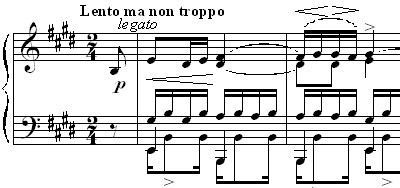 | ||
The Études by Frédéric Chopin are three sets of solo studies for the piano published during the 1830s. There are twenty-seven compositions overall, comprising two separate collections of twelve, numbered Opus 10 and 25, and a set of three without opus number.
Contents
Composition
Chopin's Études formed the foundation for what was then a revolutionary playing style for the piano. They are some of the most challenging and evocative pieces of all the works in concert piano repertoire. Because of this, the music remains popular and often performed in both concert and private stages. Some are so popular they have been given nicknames; arguably the most popular of all is Op. 10, No. 3, sometimes identified by the names "Tristesse" (Sadness) or "Farewell" (L'Adieu), as well as the Revolutionary Étude (Op. 10, No. 12). Although no nicknames are of Chopin's original creation, they create interesting pretext and encourage the imagination to fabricate epic works embodied by these studies.
All twenty-seven études were published during Chopin's lifetime; Opus 10, the first group of twelve, were composed between 1829 and 1832, and were published in 1833, in France, Germany, and England. The twelve études of Opus 25 were composed at various times between 1832 and 1836, and were published in the same countries in 1837. The final three, part of a series called "Méthode des méthodes de piano" compiled by Moscheles and Fétis, were composed in 1839, without an assigned opus number. They appeared in Germany and France in November 1840, and England in January 1841. Accompanying copies of these important early editions, there are usually several manuscripts of a single étude in Chopin's own hand, and additional copies made by his close friend, Jules Fontana, along with editions of Karol Mikuli, Chopin's student.
The first études of the Opus 10 set were written when Chopin was still in his teens. They rank alongside the early works of Mendelssohn as rare examples of extremely youthful compositions that are regarded as both innovative and worthy of inclusion in the standard canon. Chopin's études elevated the musical form from purely utilitarian exercises to great artistic masterpieces.
Impact
Although sets of exercises for piano had been common from the end of the 18th century (Muzio Clementi, J. B. Cramer, Ignaz Moscheles, and Carl Czerny were composers of the most significant), Chopin's not only presented an entirely new set of technical challenges, but were the first to become a regular part of the concert repertoire. His études combine musical substance and technical challenge to form a complete artistic form. They are often held in high regard as the product of mastery of combining the two. His effect on contemporaries such as Franz Liszt was apparent, based on the revision Liszt made to his series of concert études after meeting Chopin. Contemporary Polish musicologist Tadeusz A. Zielinski wrote, on opus 10, that "not only did they become an orderly demonstration of a new piano style and the formulas peculiar to it, but also an artistic ennoblement of this style."
Chopin's Études are not without modern influence as well. Several of his etudes have lodged themselves in popular music, movies, or television shows.
Études Op. 10
The first set of Études was published in 1833 (although some had been written as early as 1829). Chopin was twenty-three years old and already famous as a composer and pianist in the salons of Paris, where he made the acquaintance of Franz Liszt. Subsequently, Chopin dedicated the entire opus to him – "à mon ami Franz Liszt" (to my friend, Franz Liszt).
Études Op. 25
Chopin's second set of Études was published in 1837, and dedicated to Franz Liszt's mistress, Marie d'Agoult, the reasons for which are a matter of speculation.
Trois nouvelles études
Trois nouvelles études were written in 1839 as a contribution to Méthode des méthodes de piano, a piano instruction book by Ignaz Moscheles and François-Joseph Fétis, and were not given a separate Opus number. While less technically brilliant than those of Op. 10 and Op. 25, these three études nevertheless retain Chopin's original formula for harmonic and structural balance.
Preparatory exercises
for all Études
for some Études
